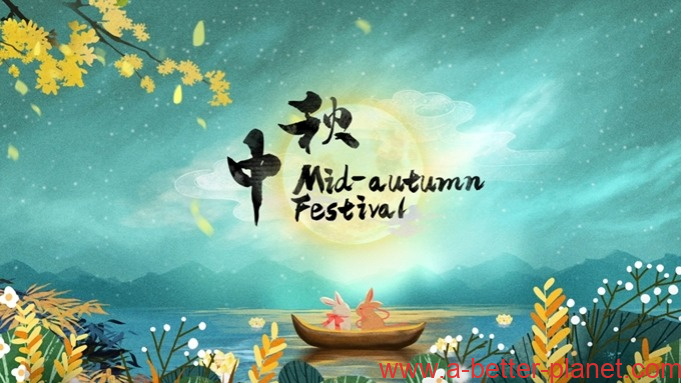
The Mid-Autumn Festival , also known as the Moon Festival or Mooncake Festival , is an important traditional festival in the Chinese character culture circle.
It is the fifteenth day of the eighth lunar month every year, from September to the beginning of October in the Gregorian calendar.
The Mid-Autumn Festival began in the early years of the Tang Dynasty and has become one of the traditional Chinese festivals as famous as the Spring Festival. Influenced by the Chinese character culture circle, the Mid-Autumn Festival is also a traditional festival for some countries in East and Southeast Asia, especially the local Chinese and overseas Chinese , celebrated in mainland China, Taiwan, Hong Kong, Macau, and Vietnam, as well as by overseas Chinese and Vietnamese communities.
Similar holidays are celebrated in Japan (Tsukimi), Korea (Chuseok), and throughout Southeast Asia.
It is one of the most important holidays in Chinese culture; its popularity is on par with that of Chinese New Year. The history of the Mid-Autumn Festival dates back over 3,000 years.

Origins
The Mid-Autumn Festival is a trace of the ancient celestial phenomenon worship-the custom of respecting the moon. In traditional culture, the moon is the same as the sun, and these two alternating celestial bodies have become objects of worship by the ancestors. In the “autumn equinox” season of the twenty-four solar terms, it is the ancient “Moon Festival”, and the Mid-Autumn Festival is from the traditional “autumn equinox”.

According to textual research, the original “Jiyue Festival” was set on the 24th solar term “autumn equinox” in the Ganzhi calendar. However, due to historical development, the calendars were later merged and the lunar calendar (xia calendar) was used. The fourteenth solar term “autumn equinox” is adjusted to the fifteenth day of August in the summer calendar.
The Mid-Autumn Festival is a synthesis of autumn seasonal customs, and most of the festival factors contained in it have ancient origins.
Mid-autumn customs

Although the Mid-Autumn Festival has developed different customs in various places, some customs are common everywhere.
Moon appreciation is one of the traditional activities of Mid-Autumn Festival in various places. The Book of Rites has long recorded “Autumn Evening and Evening Moon”, which means worshiping the moon god. At this time, there are welcoming cold and moon offerings and setting up incense cases. In the Tang and Song Dynasties, the wind of admiring the moon was more prosperous. There is also a ceremony to worship the moon.
The Mid-Autumn Festival is also a day for family reunion. People will return to their homes to eat together, reunite, and worship their ancestors to thank their ancestors for their blessing.
Celebration

They also eat certain foods, many of which are related to the moon and reunion. These foods are also sacrifices to the moon. For example, the Han, Jing (Vietnamese), and Ryukyu people have the custom of eating moon cakes, and the Japanese (Yamato) Mooncakes, mooncakes, mooncakes, and sun eggs are all round in shape, representing the full moon. Koreans eat half-moon-shaped pine chips, which symbolize the loss of the moon. Turn profit. In addition, seasonal fruits and other crops such as carambola, grapefruit, taro, chestnut, water chestnut, pear, persimmon, etc., are farmers’ autumn harvests in farming society, as well as food and sacrifices for the Mid-Autumn Festival.

There is also the custom of carrying lanterns in southern China and Vietnam, and some areas also hold large-scale lantern festivals. This custom also spread to the Chinese areas in Southeast Asia such as Singapore and Malaysia along with the early immigrants going south.
Mid-Autumn Festival is also the time when osmanthus flowers are in full bloom. Appreciating osmanthus and eating various foods made of osmanthus are also common customs in Mid-Autumn Festival. Cakes and candies are the most common.
Holiday
Since 2008, Mainland China has listed the Mid-Autumn Festival as a legal holiday.
On November 25, 2020, the “Notice of the General Office of the State Council on the Arrangement of Some Holidays in 2021” was released. The Mid-Autumn Festival of 2021 will be closed from September 19 to 21, for a total of 3 days. Work on September 18 (Saturday).
In Taiwan, there is one day off on the Mid-Autumn Festival. If it overlaps with Saturday and Sunday, there will be no additional vacation. However, if there is only one working day away from the weekly vacation, the working day will be converted to a holiday and another Saturday will be chosen to make up the shift. Make up lessons.
The statutory holiday of Mid-Autumn Festival in Hong Kong is set on August 16 of the lunar calendar (the day following the Mid-Autumn Festival). If it hits a Sunday, it will make up a day off on Monday; if it hits a Saturday, there will be no make-up holiday.
South Korea lists the Mid-Autumn Festival as a legal holiday, with a three-day holiday.